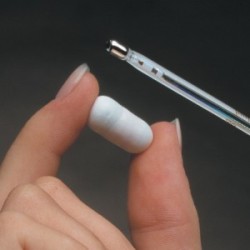In-body sensing, Bell's law, and NYT coverage of some new devices
 Saturday, June 29, 2013 at 9:18AM
Saturday, June 29, 2013 at 9:18AM  CorTemp® Ingestible Core Body Temperature SensorWearable computing is exciting, and on-body sensing is a health game-changer. But the real action will be in-body, as I learned from Dr. David Rollo of Cell Point while doing research for Your Life, Uploaded. Soon my head was full of visions of nanobots in my bloodstream and devices in my stomach that tell my cellphone what is going on inside.
CorTemp® Ingestible Core Body Temperature SensorWearable computing is exciting, and on-body sensing is a health game-changer. But the real action will be in-body, as I learned from Dr. David Rollo of Cell Point while doing research for Your Life, Uploaded. Soon my head was full of visions of nanobots in my bloodstream and devices in my stomach that tell my cellphone what is going on inside.
Naturally, Gordon Bell called this trend - Bell's Law predicts the continued formation of smaller classes of computing devices, and ever since I met him in the 90s he's talked about a world-wide network of big computers shrinking down to an on-body network of tiny devices.
Do Rollo and Bell sound like crazy futurists? Not so. Check out this New York Times article that highlights some of the devices getting ready to come to market:
They look like normal pills, oblong and a little smaller than a daily vitamin. But if your doctor writes a prescription for these pills in the not-too-distant future, you might hear a new twist on an old cliché: “Take two of these ingestible computers, and they will e-mail me in the morning.”
One of the pills, made by Proteus Digital Health, a small company in Redwood City, Calif., does not need a battery. Instead, the body is the power source. Just as a potato can power a light bulb, Proteus has added magnesium and copper on each side of its tiny sensor, which generates just enough electricity from stomach acids.
...A pill called the CorTemp Ingestible Core Body Temperature Sensor, made by HQ Inc. in Palmetto, Fla., has a built-in battery and wirelessly transmits real-time body temperature as it travels through a patient.
Firefighters, football players, soldiers and astronauts have used the device so their employers can monitor them and ensure they do not overheat in high temperatures.
 Bell's law,
Bell's law,  in-body,
in-body,  sensors in
sensors in  Health
Health 
Reader Comments